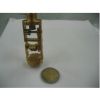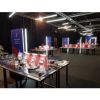Emmanuel Héré Competence Center (CC Héré)

Mechanical design and manufacture: here, a micro-mechanism for a cryogenic manipulator

Electronic design and manufacture: here, a heating electron-beam power supply

Magnetic exhibition at the Palais de la Découverte in Paris
Activities
The Emmanuel Héré Competence Center (CC Héré) gathers the technical and human resources which are necessary to the researchers’ experimental activity.
Because of its multiple fields of expertise, the CC Héré is able to offer a wide range of services in the following areas: mechanics, electronics, electrical engineering, interfacing, industrial computing, etc. It is able to design, manufacture and develop original experimental devices for the benefit of research.
CC Héré covers a broad field of skills, and has the capacity to unify disciplinary approaches around a common issue. This stimulates the synergy effect that is necessary for the engineering of complex systems.
Its transdisciplinary structure fosters a global systemic approach that is complementary to traditional analytical approaches, to propose innovative concepts or products.
The 5 main categories of CC Héré activities are:
- Design and manufacture of mechanical assemblies
- Design and production of associated measurement electronics
- Construction or modification of ultra-high vacuum chambers
- Production of custom-made frames
- Interfacing and instrument control
Equipment
- Design office / methods office (CAD/CAM: TopSolid, SolidWorks)
- Mechanical workshop (5-axis simultaneous machining centre, 3-axis digital lathe, conventional milling machines and lathes, cylindrical grinding machine, etc.)
- Workshop for cutting and shaping of materials
- Ceramic and glass machine shop
- Electronics workshop
- Printed circuit board engraving workshop
- Welding workshop (TIG / MIG)
- Workshops for cleaning and assembly of ultra-high vacuum equipment
- Fab lab (laser cutting, 3D printer, stratoconception, thermoforming, etc.)
Examples of achievements
Device with 32 concentric Langmuir electrostatic probes, for the study of specific properties of electrostatic turbulence in a magnetised plasma column:
The aim is to access electric field fluctuations at different poloidal positions, taking into account a complete circumference of the plasma column at different radii. Multi-probe systems exist, but these require the plasma to be halted and the machine to be opened to vary the measuring radius. It was difficult to create an in situ adjustable system that offers a large number of poloidal measuring points to obtain the best possible resolution. CC Héré designed this instrument by imagining a crown with 32 probes extending like a diaphragm. This system allows the measurement of the radial transport generated by turbulent plasma structures with an exploration diameter varying from 30 to 140 mm. In
addition to the device, CC Héré designed and built all the electronics that served for signal conditioning and measurement. This instrumentation allowed each probe to be polarized at adjustable DC potentials, to measure the ion saturation current or to configure the probes in high impedance to measure the floating potential of the plasma and to deduce the poloidal electric field.
Development of a system for the safety of people (iDATI):
This device differs from mandown detection telephones by its ability to carry out immediate actions, associated with the triggering of classic alerts (tel, e-mail).
Originally designed to address a security issue in the IJL's risk laboratories, the system adds a whole range of functions to the traditional remote alarm function, enabling direct interaction with the environment to neutralize sources of risk in the event of an alert. In this way, real added value in terms of personal protection is provided.
These functions include, for example, the control of an element (gas valve, smoke extractor, emergency stop, door strike, etc.), the detection of the approach of a danger or a forbidden zone, geolocation (including indoors), interfacing with a building supervision system, or communication with connected objects.
"Magnetic" exhibition:
This 250 m² exhibition, presented at the Palais de la découverte in Paris from 2019/11/05 to 2020/11/29, is made up of five thematic blocks offering t to "show science in the making" to the public. The aim is to gradually provide the public with the knowledge needed to understand some of the results of research currently carried out at the IJL in the field of magnetism, through experimental devices.
The exhibition presents about sixty models, most of which are interactive and all of which are prototypes designed and manufactured at the CC Héré. The infrastructure and the models developed meet extremely demanding specifications, linked to several factors. These are the exhibition's roaming constraints, the reliability and robustness of the models, the necessarily pedagogical qualities of the models developed, the safety standards specific to establishments open to the public, and the aesthetics that are essential to the advent of an ambitious project.
This requires multidisciplinary skills in design engineering and manufacturing, in the fields of mechanics, electronics, electrical engineering, interfacing and industrial computing, making CC Héré a first-choice center to bring out the synergies necessary for the creative approach of this project. Thus, all the productions of the exhibition, from the infrastructure to the scenography, from models to lighting sources or lighting supports of cartels, are original prototypes developed within CC Héré.
Our services
The CC Héré group accompanies and assists you during the study, design, and prototyping phases of your products. By favouring a global systemic approach in an agile developmental mode, you will be able to rapidly develop your most innovative products.
Members
Contact
Head of competence center
Christophe BONNET
christophe.bonnet@univ-lorraine.fr
+33 (0) 3 72 74 24 33
Administrative contact
Pascal THIS
pascal.this@univ-lorraine.fr
+ 33 (0)3 72 74 25 02
Nancy-Artem
Institut Jean Lamour
Campus Artem
2 allée André Guinier - BP 50840
54011 NANCY Cedex

